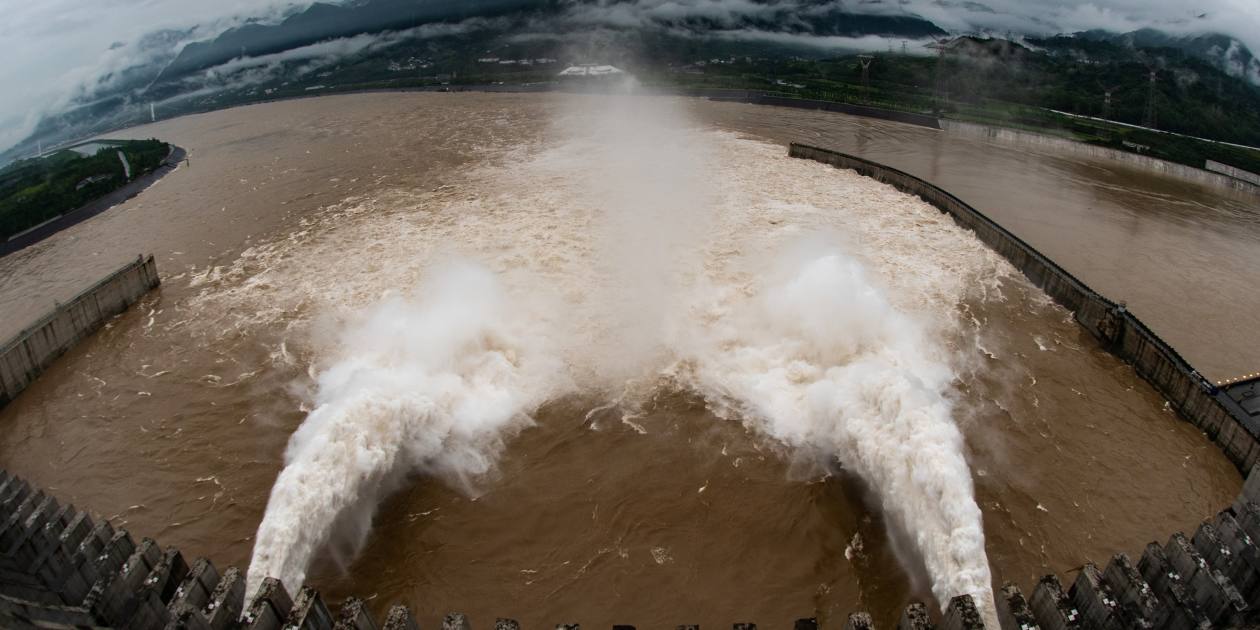beijingwalker
ELITE MEMBER

- Joined
- Nov 4, 2011
- Messages
- 65,191
- Reaction score
- -55
- Country
- Location
China can't just keep building the world's biggest dam in secret
Brahmaputra project poses risks for India and BangladeshBrahma Chellaney
July 14, 2023 17:00 JST

The Three Gorges Dam discharges water to lower reservoir levels following heavy rain. China latest hydropower project would be three times bigger. © Reuters
China is unmatched as the world's hydro hegemon, with more large dams in service than every other country combined. Now it is building the world's first super dam, close to its heavily militarized frontier with India.
This megaproject, with a planned capacity of 60 gigawatts, would generate three times as much electricity as the Three Gorges Dam, now the world's largest hydropower plant. China, though, has given few updates about the project's status since the National People's Congress approved it in March 2021.
Opacity about the development of past projects has often served as cover for quiet action. Beijing has a record of keeping work on major dam projects on international rivers under wraps until the activity can no longer be hidden in commercially available satellite imagery.
The super dam is located in some of the world's most treacherous terrain, in an area long thought impassable.
Here, the Brahmaputra, known to Tibetans as the Yarlung Tsangpo, drops almost 3,000 meters as it takes a sharp southerly turn from the Himalayas into India, with the world's highest-altitude major river descending through the globe's longest and steepest canyon.
Twice as deep as the U.S. Grand Canyon, the Brahmaputra gorge holds Asia's greatest untapped water reserves while the river's precipitous fall creates one of the greatest concentrations of river energy on Earth. The combination has acted as a powerful magnet for Chinese dam builders.
The behemoth dam, however, is the world's riskiest project as it is being built in a seismically active area. This makes it potentially a ticking water bomb for downstream communities in India and Bangladesh.
The southeastern part of the Tibetan Plateau is earthquake prone because it sits on the geological fault line where the Indian and Eurasian plates collide.
The 2008 Sichuan earthquake, along the Tibetan Plateau's eastern rim, killed 87,000 people and drew international attention to the phenomenon of reservoir-triggered seismicity (RTS).
Some Chinese and American scientists drew a link between the quake and Sichuan's Zipingpu Dam, which came into service two years earlier near a seismic fault. They suggested that the weight of the several hundred million cubic meters of water impounded in the dam's reservoir could have triggered RTS or severe tectonic stresses.
But even without a quake, the new super dam could be a threat to downriver communities if torrential monsoon rains trigger flash floods in the Great Bend of the Brahmaputra. Barely two years ago, some 400 million Chinese were put at risk after record flooding endangered the Three Gorges Dam.
Meanwhile, the 11 large dams China has built on the upper reaches of the Mekong have had many negative ecological impacts, including recurrent drought, for downriver nations. But not only is China constructing more big dams on the Mekong, it is now also turning its attention to tapping the bounteous water resources in the Brahmaputra Basin.
In pursuing its controversial megaproject on the Brahmaputra, China is cloaking its construction activity to mute international reaction.
China presented the super dam project for the approval of the National People's Congress only after it had built sufficient infrastructure to start transporting heavy equipment, materials and workers to the remote site.
Barely two months after parliament's approval two years ago, Beijing announced that it had accomplished the feat of completing a "highway through the world's deepest canyon." That highway ends very close to the Indian border.
The following month, Beijing announced the launch of a new rail line from Lhasa to Nyangtri, a frontier military base less than 16 kilometers from the India border. In fact, President Xi Jinping began a surprise tour of Tibet in July 2021 from Nyangtri, taking the new train from there to the regional capital.
The new infrastructure indicates that work on the dam's foundation likely began quietly after the opening of the railroad and highway.
The Brahmaputra was one of the world's last undammed rivers until China began constructing a series of midsized dams on sections upstream from the famous canyon. With its dam building now moving close to border areas, China will in due course be able to leverage transboundary flows in its relations with rival India.
But the brunt of the environmental havoc that the megaproject is likely to wreak will be borne by Bangladesh, in the last stretch of the river. The environmental damage, however, is likely to extend up through Tibet, one of the world's most biodiverse regions. In fact, with its super dam, China will be desecrating the canyon region which is a crucial Tibetan holy place.
A cardinal principle of water peace is transparency. The far-reaching strategic, environmental and inter-riparian implications of the largest dam ever conceived make it imperative that China be transparent. Only sustained international pressure can force Beijing to drop the veil of secrecy surrounding its project.

China can't just keep building the world's biggest dam in secret
Brahmaputra project poses risks for India and Bangladesh






 , 95% of the water in the Brahmaputra comes from streams well into the Indian side which originate due to monsoon.
, 95% of the water in the Brahmaputra comes from streams well into the Indian side which originate due to monsoon.

